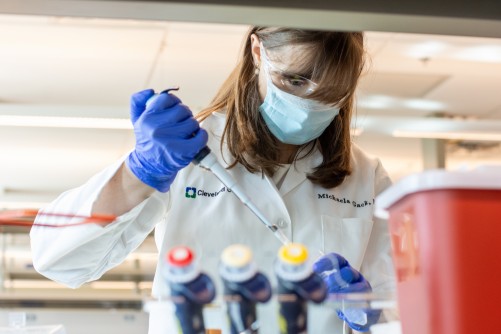Researchers from Cleveland Clinic’s Florida Research and Innovation Center (FRIC) found that disruption of a cellular structure, known as the actin cytoskeleton, is a “priming signal” for the body to respond to a virus. These findings, published in Cell this week, potentially lay the groundwork for development of new anti-viral vaccines and treatments.
Previously, viral genetic material such as RNA was considered the sole requirement for certain sensor molecules that live in cells to trigger an immune response – an “alarm system” for many types of cells. RNA also serves as a basis for vaccines through training a patient’s immune system to recognize a virus. This new study showed that the signaling process also requires disrupting the actin cytoskeleton inside cells, which occurs when a virus infects cells.
“It’s a fundamental new way of considering how the immune system can be activated, and the implications are that this could lead to broad antiviral therapeutics,” says Michaela Gack, PhD, the Arthur and Marylin Levitt Endowed Chair and scientific director of the FRIC. “Our data shows this process is common across different types of RNA viruses.”
Cytoskeletons, made up of the protein actin, serve as structural support for cells but are also key in processes like the cell’s ability to grow, divide and internalize key substances. A virus disturbs the cytoskeleton, but so can vaccine components and certain therapeutics, Gack says.
“Whether this process is sensed by our cellular immune surveillance system and can trigger an antiviral response has been unknown,” says Gack. “Our work showed that specific immune receptors sense actin cytoskeleton rearrangements induced by viruses and then trigger alarm.”
Despite being around for decades, interest in using RNA as the basis for vaccines and therapeutics grew exponentially during the COVID-19 pandemic. The research showed that the triggering system is similar across multiple viruses, including Zika, the flu or SARS-CoV-2, the virus that causes COVID-19.
Gack’s team, including lead author Dhiraj Acharya, PhD, research associate at FRIC, also discovered that lipid components or virus-like particles such as those used in vaccines or RNA-based therapeutics can cause the cytoskeletal disturbance necessary for prompting an immune response. These results could help developers “fine-tune” the immunostimulatory potencies of therapeutics or vaccines.
Gack’s lab, operating under Cleveland Clinic’s multi-site Global Center for Pathogen and Human Health Research, investigates virus-host interactions on a molecular level, identifying host responses that can play a key role in developing new treatments and vaccines. The center is a cornerstone of the Cleveland Innovation District.
The study was a collaboration with Konstantin Sparrer, Ph., of Ulm University in Germany, and other collaborators from multiple institutions.
Source: Cleveland Clinic
